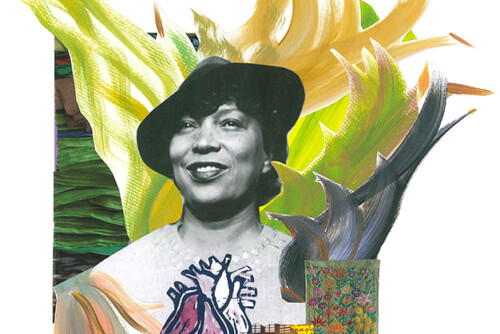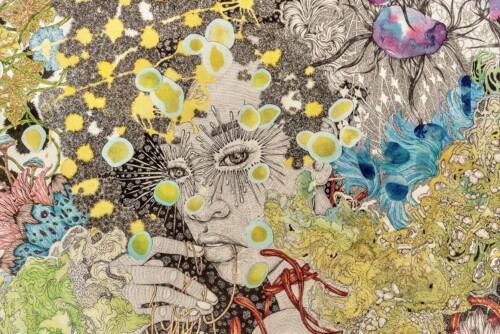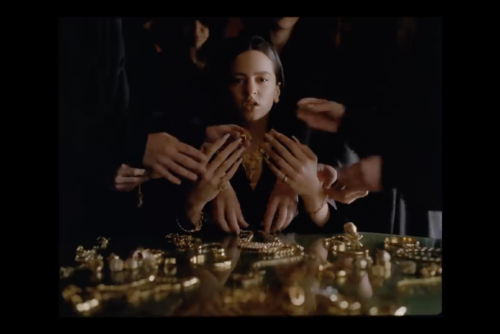I.
In In Search of Our Mother’s Gardens, Alice Walker famously characterizes Hurston as always upholding a sense of “racial health – a sense of black people as complete, complex, undiminished human beings.”1 To be undiminished in this way requires a healthy dose of irony, a robust sense of humor, a profound commitment to endurance, and a deep love. … I embrace love because I embrace contingency, process, disaggregation, playfulness, surprise, and improvisation. I embrace love because before I was an anthropologist, I was a dancer, and as all dancers know, there is that moment when body becomes spirit becomes something more, when we become consciously human by doing something – with our bodies – together. I embrace love when I am laughing, and then again when I am feeling mean and impressive. I embrace love in the little repetitions of everyday life: making breakfast, school drop-offs, teaching class, endless meetings. I experience these repetitions like the chants, thumps, or dances of Revival, Kumina, and other Afro-diasporic spiritual traditions in which repetition is intended to produce a state of trance. In this state, we communicate with beings and things unseen, we exceed our bodies, we time travel. This threshold state enables affective mutuality and gives us a sense of how, when, and why the feeling of freedom counteracts the constraints of historical violence in the present. To love is the most radical thing we can do today.
We begin here with the ending of Deborah Thomas’s essay in this volume because at the time of writing it is the summer of 2020 and we have been contemplating the difficulty and necessity of knowing just how “the feeling of freedom counteracts the constraints of historical violence in the present.” We have been thinking deeply and critically about love: love of self, love of family and community, love of country. Given that we are in the midst of a global pandemic, an unprecedented reckoning with centuries of racial violence and injustice, and an historic economic crisis, it is a good time to (re)read Hurston and scholars on Hurston. Hurston offers us so much, but what she offers most is love: love of self, love of community, love of the language that bonds self, community, and culture together.
This summer, we turn to Hurston and other Black thinkers, for whom the phrase and sentiment “Black Lives Matter” was never a question, but a grounding principle from which all action, cultural and political, grows. In the recent uprisings for social and racial justice, we have seen a renewed and righteous, urgent (and curious) attention and affiliation to all things Black: a weird, wonderful, necessary, and sometimes uncomfortable version of a moment Hurston knew so well, the “Negro being in vogue.” What Hurston teaches us in this moment, what she emphasized that first time nearly 100 years ago, and what we need to remember as we reckon with history, tarry, and move forward, is the sense of love to which Thomas points here. This love is present in everyday rituals of care and devotion to self and community that characterize the state of “racial health” that Hurston preached and lived and wrote about to continually re-affirm – “a sense of black people as complete, complex, undiminished human beings.”
In the last few months, I have been thinking about and alongside so many of our literary and cultural icons. James Baldwin has re-emerged as a talisman of sorts as we have attempted to, once again, diagnose and treat America’s dis-ease, plumb the depths of what ails us as a nation and a people: the fundamental lie of equality on which this country is built. Baldwin’s words have been swirling in the air, guiding our outrage and moral courage. That these phrases are well-worn and also so patently relevant produces melancholy and resolve. We remember, “I imagine one of the reasons people cling to their hates so stubbornly is because they sense, once hate is gone, they will be forced to deal with pain”; we repeat, “I can’t believe what you say, because I see what you do”; we intone, “to be a Negro in this country and to be relatively conscious is to be in a rage almost all the time” as we march the streets in protest, celebration, and demonstration of old, hard-earned knowledges.
Echoing also in my head, in quieter moments of reflection, are the words of Ralph Ellison, who, in the epilogue of Invisible Man famously asks a series of questions about knowing and doing with which we are still grappling:
Could he have meant – hell, … that we were to affirm the principle on which the country was built and not the men, or at least not the men who did the violence. Did he mean to say “yes” because he knew that the principle was greater than the men, greater than the numbers and the vicious power and all the methods used to corrupt its name? Did he mean to affirm the principle, which they themselves had dreamed into being out of the chaos and darkness of the feudal past, and which they had violated and compromised to the point of absurdity even in their own corrupt minds? Or did he mean that we had to take the responsibility for all of it, for the men as well as the principle, because we were the heirs who must use the principle because no other fitted our needs? Not for the power or for vindication, but because we, with the given circumstance of our origin, could only thus find transcendence? Was it that we of all, we, most of all, had to affirm the principle, the plan in whose name we had been brutalized and sacrificed – not because we would always be weak nor because we were afraid or opportunistic, but because we were older than they, in the sense of what it took to live in the world with others and because they had exhausted in us, some—not much, but some – of the human greed and smallness, yes, and the fear and superstition that had kept them running. (Oh, yes, they’re running too, running all over themselves.) Or was it, did he mean that we should affirm the principle because we, through no fault of our own, were linked to all the others in the loud, clamoring semi-visible world, that world seen only as a fertile field for exploitation, … who were tired of being the mere pawns in the futile game of “making history”? Had he seen that for these too we had to say “yes” to the principle, lest they turn upon us to destroy both it and us?2
Like Baldwin, Ellison is talking about the founding principles of the United States and their corruption, about the afterlife of that history, asking seriously and with urgency how Black people are to confront and negotiate the violation, respond with righteousness. He is asking if it is possible to affirm the rhetoric, make it real in a new moment of “doing” that demands more of all of us. With Baldwin, he wants to know how to parse (and perhaps transcend) the contradiction between the saying and the doing in order to reach and live inside the freedom dream.
Baldwin and Ellison put words to our national and enduring condition, while Hurston gives us yet another path to freedom and liberatory knowledge. In her writing, Hurston operates not on this precipice of saying and doing, which form the boundaries of white and Black worlds, but instead approaches story, living, and life from inside of Blackness and undiminished Black worlds. As I’ve read Hurston this summer, and also the scholars assembled here on Hurston, I have been asking what was or is “the principle” for Hurston and how does this issue of Scholar and Feminist Online help us get at it and, if possible, vision with and beyond it? Hurston was always looking askance at and revising for herself “the principle on which the country was built,” and also “the men, or at least … the men who did the violence.” As such, her horizon centered Black women who were living in the diaspora, ambitious in both small and monumental ways, toiling mightily for something beyond mere survival while never denying the struggle for a sense of joy and grace. It is worth repeating and never forgetting, as Thomas reminds us, that Hurston loved herself and us when she was laughing, and then again when she was feeling mean and impressive. “Her people, her people” were always her primary, unwavering subject and concern. Hurston never denied she was “living on earth, trying to board in heaven,” but she considered the fact and the joy of her Blackness and Black culture the principle for and of her life, literary, and anthropological work. Inside her multimodal, interdisciplinary, fecund imagination, which she opened up to all of us, she was always and enduringly free. Undiminished.
II.
In the fall of 2016, we invited the contributors assembled here to participate in the Hurston@125 symposium, a joint project of the Barnard Center for Research on Women and the Department of Africana Studies. A celebration of what would have been Hurston’s one hundred and twenty-fifth birthday, this symposium was meant to offer another revision and reimagination of Hurston’s creative and scholarly work and its impact. Barnard last hosted a Hurston conference in 2003 in the midst of Zoromania, a moment that commemorated, among other things, the seventy-fifth anniversary of her graduation from Barnard, a new authoritative biography, a new collection of her letters, the issuance of a postage stamp that bore her image, and the Oprah Winfrey-produced and Suzan-Lori Parks-authored film adaptation of Their Eyes Were Watching God, starring Halle Berry. By 2003, nearly all of the work published during her lifetime – four novels, two books of folklore, an autobiography, and numerous short stories, plays, and essays – was back in print, along with folklore, short stories, and plays not published when she was alive. If our last Hurston symposium reassessed of Hurston’s life and work, Hurston@125 recognized the incredible growth that Hurston studies had in the years between, as intellectual and creative work on and with her legacy has expanded within and across academic disciplines, particularly literary study and anthropology. Hurston’s work and the intellectual and creative responses that it elicits and provokes more firmly plants her and her multidisciplinary thinking and multimodal work at the center of much contemporary literary and cultural inquiry. We see in Hurston evidence of theories of waywardness, fugitivity, sound and time studies, animal studies, and eco-criticism. We have come to a time where we can say that “she had it, you cannot deny it,” when thinking of innovative, liberatory ways of communicating the genius of Black life and culture – this in an echo of my all-time favorite phrase of hers: “Those that don’t got it, can’t show it. Those that got it, can’t hide it.”
In 2020, Hurston’s work is undeniable as occasion for cultural theory and also as this theory itself; it is becoming a foundational touchstone to some of the most innovative work in anthropology, literary study, and media studies. Though composed of six short essays, this volume goes a long way in this next round of Hurston scholarship and reveals a glimpse of not only Hurston’s intellectual striving, but also what it can mean to create space for others out of the genius of your own mind and the ways and words of your people. Using Hurston as a talisman, all of these contributors open space up for others to dwell in, challenging what we know about Hurston’s oeuvre and expanding our ability to think into the future with her.
This volume features new work by emerging and junior scholars. Alex Alston, Mariel Rodney, and Autumn Womack explore Hurston’s novels, stories, essays, folklore, and filmic practice as a form of literary or narrative theory, as well as a theorization of avant-garde literary and visual practices. Investigating Hurston’s engagement with blackface minstrelsy as a counterintuitive practice of refusal, the creation of a “blackened knowledge,” Rodney forms a dialogue with Womack, who describes a similar fugitivity in what she calls Hurston’s tendency for “overexposure” in her filmic practice, which “disrupts and reconfigures many of the strategies, practices, and tropes used historically to structure Blackness as a knowable subject.” Alston’s exploration of Hurston’s fascinating and innovative signifying on the dreaded comparison between human and animal in her fiction, prefiguring animal studies, allows him to ask a new set of questions about how “the folk” and the metaphorical language used to describe them fit into Hurston’s Black-centered and life-affirming work. Patricia Stuelke, in an essay on Seraph on the Sewanee, Hurston’s only novel to feature white characters which she wrote on a research trip to Honduras, similarly probes race, class, and gender via Hurston’s prominent figuration of the swamp. “Draining the swamp,” in Seraph on the Sewanee, leads to an examination of Hurston’s fear of and sympathy for white femininity and the complex politics of colonial and imperialist “improvement” projects then and now. Stuelke, along with Adriana Garriga-Lopez and Deborah Thomas, take Hurston’s work into new territory as their contributions are grounded in literary and ethnographic connection with Central America and the Caribbean and its multiple diasporas. In particular, Thomas and Garriga-Lopez use Hurston’s Caribbean explorations as a base for critiques of US imperialism and neoliberal policies in the region, and write in what many see as a modern, decolonized, anthropological and literary analysis. These writers highlight the multiple contemporary sociocultural processes involved in making “place,” and identity and draw us into a dialogue about Hurston’s legacy in multiple fields.
In order to see this growth in Hurston studies and also to understand the through lines, in particular from the late 1970 when Black feminist writers and critics “recovered” Hurston, we include Mary Helen Washinton’s groundbreaking introduction to the recently re-issued anthology of Hurston’s writing I Love Myself When I Am Laughing…: A Zora Neale Hurston Reader, edited by Alice Walker (Feminist Press, 1979/2019). The essay is titled “Zora Neale Hurston: A Woman Half in Shadow.” As Washington notes, “Hurston was determined to write about black life as it existed apart from racism, injustice, Jim Crow – where Black people laughed, celebrated, loved, sorrowed, struggled – unconcerned about white people and completely unaware of being ‘a problem.’“
III.
At the end of “Looking for Zora,” the historic essay where Alice Walker describes her search for Hurston’s unmarked grave and her placement of a marker on the site in Florida, Walker writes of the gravity and absurdity of her gesture:
There are times – and finding Zora’s grave was one of them – when normal responses of grief, horror, and so on, do not make sense because they bear no real relation to the depth of the emotion one feels. It was impossible for me to cry when I saw the field of weeds where Zora is. Partly because I have come to know Zora through her books and she was not a teary sort of person herself; but partly too, it is because there is a point at which even grief feels absurd. And, at this point, laughter gushes up to retrieve sanity.
It is only later, when the pain is not so direct a threat to one’s own existence that what was learned in that moment of comical lunacy is understood. Such moments rob us of both youth and vanity. But perhaps they are also times when greater disciplines are born.3
We return to Hurston again and again. When we arrive, she is both always already there and also ahead of us. Just a small part of what makes Hurston’s writing life and career so extraordinary was her discipline, in the form of the passion and extremely hard work she put into trying to be one of the first Black women to support herself with her writing. She did this as a necessity to and for herself and as a gift to Black people and the world. Hurston’s discipline, her devotion and everyday practice of creative and critical thinking, is not just an inspiration to us in this remarkable year, but also a strategy. When Walker speaks of Hurston’s “discipline” above, she implies that Black feminist writers and thinkers like herself can use Hurston as a kind of North Star, steering their “ships at a distance” through the uncertainty, pain, and struggle of the past and present towards the future. What she also implies, when discipline is read doubly, is that having Hurston as a writerly and scholarly companion also enables us to exceed our own disciplines and find and create others. With Hurston, we remain undiminished – in body and thought. With love.
- Alice Walker, In Search of Our Mother’s Gardens: Womanist Prose (New York: Harcourt, 1983), 85. [↩]
- Ralph Ellison, Invisible Man (New York: Random House, 1994). [↩]
- Alice Walker, “Afterword: Looking for Zora,” I Love Myself When I am Laughing… : A Zora Neale Hurston Reader (Old Westbury: Feminist Press, 1979), 313. [↩]




